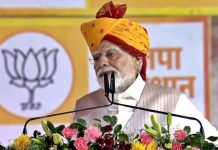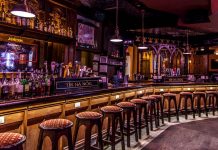
Traders at Pukka Bagh in Moradabad, which is UP’s biggest Islamic clothing market, claim that instead of adversely affecting the business, anti-Hijab protests sparked spurt in sales. It seems the row made the community to take to wearing of hijab with more zeal, writes Kulsum Mustafa
In the narrow, long, meandering lanes in Moradabad’s congested Pukka Bagh which houses Uttar Pradesh’s biggest Islamic clothing outlets, out of the 200 odds shops, largely selling women’s clothing, jewellery, and cosmetics around 50 shops exclusively sell abayas, hijab, chaddar, stoles, scarf caps, and traditional burqas and umera clothing. These are available here in retail and also wholesale. Peetalnagri or City of Brass is also the state’s leading center for Islamic clothing.
“Ours is the biggest market in Uttar Pradesh, compared only to Hyderabad and Mumbai. While we supply to the nearby districts like Bijnore, Bareilly, Najibabad, Rampur, Lucknow, etc, our products are also distributed to other parts of India,” said Shehzad Raja, owner of the biggest store of these clothing, which dates back to over 25 years..
Explaining the difference between hijab and burqa, he said that Abaya is the Arabic word for a loose outer garment. It is worn both by men and women. Burqa, also an Arabic term for a loose-fitting garment that covers the head, face, body, and sometimes the eyes. It is exclusively for women.
Shehzad claimed that instead of affecting their business, the sale of these Islamic clothing increased after the anti-Hijab protests in Karnataka and also in parts of UP. Explaining the fashion of designer hijabs and Abaiyas instead of the traditional black burqas, Shehzad gave the credit to the trend of holding large wedding receptions, many times in mixed gatherings in banquet halls instead of at home.
He explained that women now have to travel far for wedding functions which are organized in hotels and resorts, because of this the traditional burqa, which was an outer garment and was taken off at the threshold of the wedding venue has changed into a formal abaya, which serves the dual purpose of both a covering as well as the formal dress. He said that Abaya or hijab is a style statement now.
Shehzad’s 20-year-old son Aman Ali, who has been in this business for nine years agrees to his father’s contention and states that it is now all the more important that they stock the latest designs. The range of Abayas in his shop is huge. They start from Rs 600 and go up to Rs 1500. “Youngsters are forever looking for new designs and thanks to the internet, they are aware of the hot-selling designs in Saudi and Dubai. So we customize what they desire,” added Aman.
Agreeing that the customers have become very choosy now regarding the abaya and hijab, Mohd Imran of MA Cloth House said that the sellers have to stock the latest replicas which are trending in Muslim countries. He said most of the material for these garments is imported from China, local tailors are used for turning them into copies. The price in Moradabad market is very low compared to the original garment prices which may go up as high as 35,000.
According to Abdul Qadir, the Abaya trend has picked up in the last few years and the anti-hijab stir, which, according to him, was a political gimmick, only made the community take up the wearing of hijab with more zeal.
“Girls in the age group of 6 to 10 are also donning hijab nowadays and that has given a thrust to the Hijab industry all over India,” said Mohd Imran who manages his grandfather’s shop of over a quarter century.
Retail Prices
Abaiya —————Rs 700 TO Rs 7000
Hijab ………………Rs 150 TO Rs 600
Chaddar…………….Rs 200 TO Rs 600
Stole……………….Rs 150 TO Rs 500













